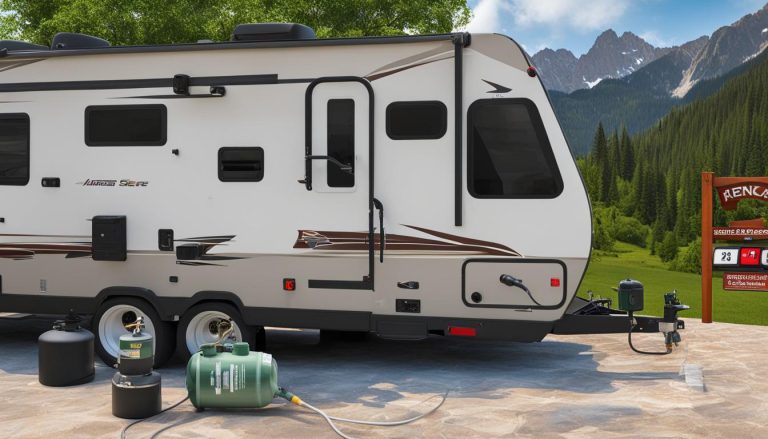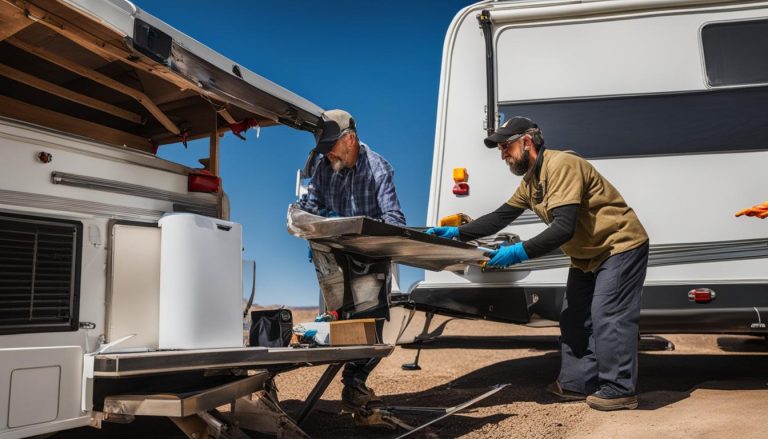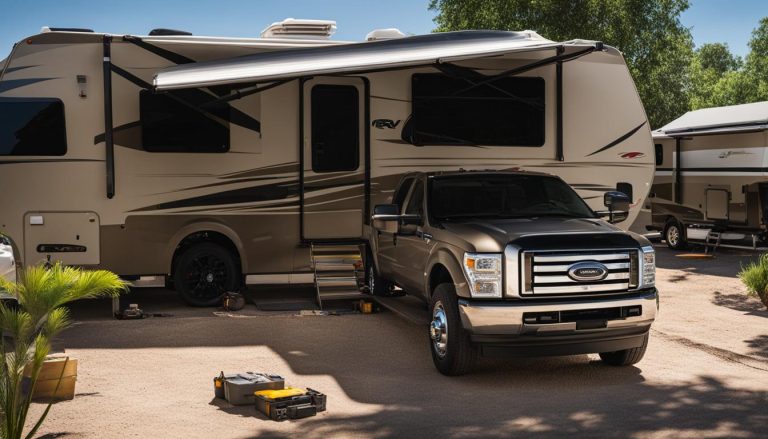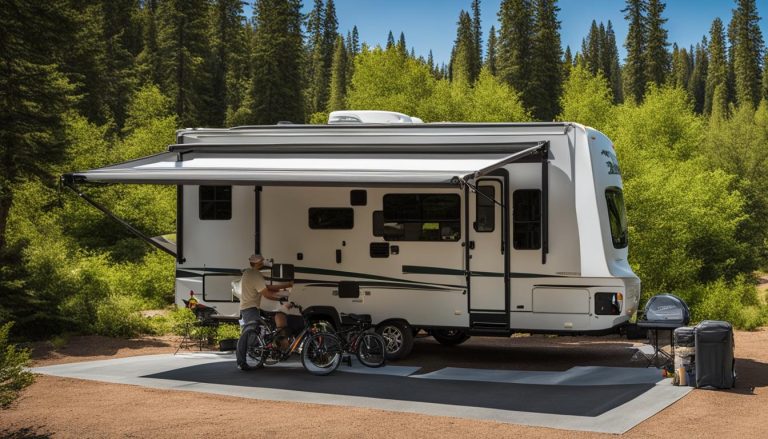Sanitize Your RV Fresh Water Tank Effectively
gorvlifestyle.com and its partners may earn a commission if you purchase a product through one of our links
Regularly sanitizing your RV fresh water tank is an essential maintenance task to ensure clean and safe water during your travels. By following a simple step-by-step process, you can effectively sanitize your tank and eliminate harmful bacteria, mold, and mildew. In this section, we will guide you on how to clean your RV fresh water tank and provide helpful tips for maintaining a clean water system.
Key Takeaways:
- Sanitizing your RV fresh water tank is important for maintaining clean and safe water.
- Regular sanitization helps prevent the growth of bacteria, mold, and mildew in your tank and water lines.
- It is recommended to sanitize your fresh water tank every six months or if you notice any odd taste or smell in your water.
- To effectively sanitize your RV fresh water tank, you will need bleach, a funnel, clean water, and follow a step-by-step process.
- Proper maintenance of your RV water tank ensures the quality of your water and prolongs the lifespan of your water system.
Why Sanitize Your RV Fresh Water Tank?
Sanitizing your RV fresh water tank is crucial to ensure the health and safety of you and your family while on the road. The water used to fill your tank may not always be clean, and bacteria, mold, and mildew can grow in the tank and water lines over time. By sanitizing your fresh water tank, you eliminate any potential sources of contamination and keep your water system clean and fresh. Regular maintenance of your RV water tank helps prevent unpleasant odors, ensures the quality of your water, and prolongs the lifespan of your water system.
When it comes to RV water tank cleaning and maintenance, it’s important to understand why sanitizing your fresh water tank is so essential. The water used to fill your tank may come from various sources, such as campground hookups or natural water sources, and these sources aren’t always guaranteed to provide clean water. Without proper sanitization, your RV’s water tank can become a breeding ground for bacteria, mold, and mildew that can negatively impact your health and the overall quality of your water system.
By regularly sanitizing your RV fresh water tank, you effectively eliminate any potential sources of contamination and ensure that the water you use for drinking, cooking, and cleaning is safe. This not only helps to prevent illnesses caused by bacteria, but it also helps to prevent unpleasant odors that can develop when bacteria and mold grow in the tank. Additionally, maintaining a clean fresh water tank in your RV can help prolong the lifespan of your water system, saving you time and money on repairs or replacements.
To illustrate the importance of sanitizing your RV fresh water tank, consider the following benefits:
- Ensuring clean and safe water for drinking and cooking
- Preventing the growth of bacteria, mold, and mildew
- Eliminating unpleasant odors in your water system
- Prolonging the lifespan of your water system
When you prioritize RV water tank cleaning and maintenance by regularly sanitizing your fresh water tank, you can enjoy clean and fresh water throughout your travels, providing peace of mind for you and your family.
Sanitizing your RV fresh water tank is crucial to ensure the health and safety of you and your family while on the road.
| Benefits of Sanitizing Your RV Fresh Water Tank |
|---|
| Ensuring clean and safe water |
| Preventing the growth of bacteria, mold, and mildew |
| Eliminating unpleasant odors in your water system |
| Prolonging the lifespan of your water system |
When to Sanitize RV Fresh Water Tank Systems
Knowing when to sanitize your RV fresh water tank is essential for maintaining the cleanliness and quality of your water system. While regular sanitization every six months is recommended as part of routine maintenance, there are a few situations where immediate sanitization may be necessary.
If you notice any strange taste or smell in your water, it’s a clear indication that your RV fresh water tank needs sanitizing. Unpleasant odors or flavors could be a sign of bacterial or mold growth in the tank.
If your RV has been in storage for an extended period, it’s crucial to sanitize the fresh water tank before using it again. Stagnant water can promote the growth of bacteria and other contaminants, compromising the safety of your water supply.
Additionally, if you suspect that the water used to fill your tank was not clean, it’s highly recommended to sanitize your tank. Water from unfamiliar sources or questionable quality can contain harmful bacteria, making sanitization necessary to maintain the safety of your water system.
Regular monitoring of the condition of your water and being proactive in sanitizing your RV fresh water tank will ensure the continued safety and quality of your water supply.
Important note:
Sanitizing your RV fresh water tank is not only about cleaning the tank itself but also about ensuring the cleanliness of your entire water system, including the water lines. Neglecting to sanitize your tank can lead to the growth of bacteria, mold, and mildew, which can compromise your health and the functionality of your water system.
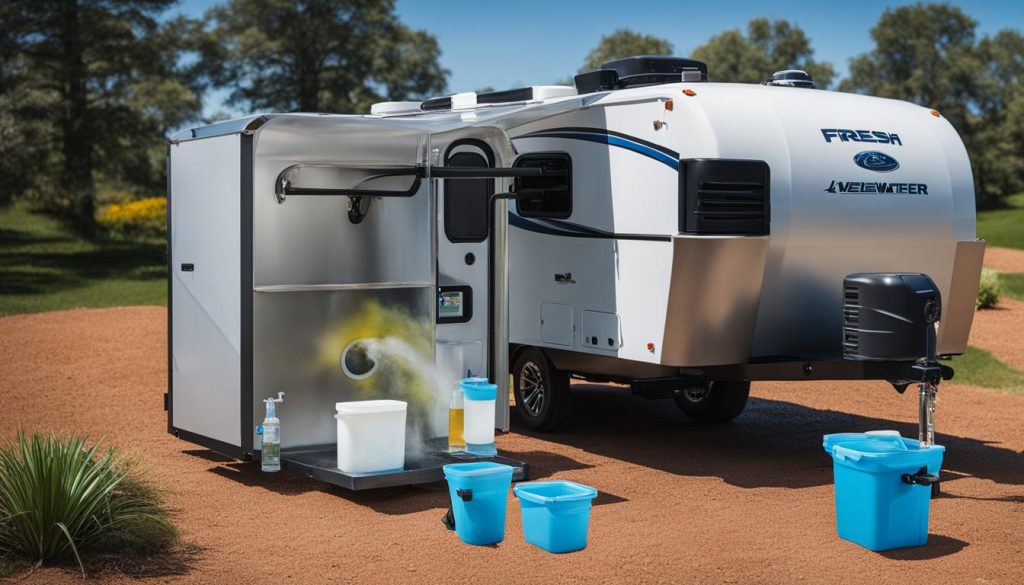
| Signs it’s time to sanitize your RV fresh water tank: |
|---|
| 1. Strange taste or smell in the water |
| 2. RV has been in storage for a while |
| 3. Suspected contaminated water source |
What You Need to Sanitize RV Fresh Water Tank and System
When it comes to sanitizing your RV fresh water tank, you don’t need any specialized tools. You just need a few basic supplies that can easily be found. Here’s what you’ll need:
- A bottle of non-scented bleach or RV tank sanitizer
- A funnel
- A clean water source
Using non-scented bleach or RV tank sanitizer is crucial to avoid any unwanted flavors or odors in your water system. You want your water to be clean and refreshing, so it’s important to choose the right products. The amount of bleach you’ll need depends on the size of your fresh water tank. As a general guideline, use about 1/4 cup of bleach for every 15 gallons of water in your tank.
Having these supplies readily available will make the process of sanitizing your RV fresh water tank quick and easy. By following the proper steps and using the right tools, you can ensure that your water system remains clean and safe for your next adventure.

| Supplies | Quantity |
|---|---|
| Non-scented bleach or RV tank sanitizer | As needed (about 1/4 cup for every 15 gallons of water) |
| Funnel | 1 |
| Clean water source | As needed |
How to Sanitize RV Fresh Water Tank
Keeping your RV fresh water tank clean is essential for ensuring a safe and enjoyable camping experience. Follow these step-by-step instructions to effectively sanitize your RV’s fresh water tank and water system:
- Prepare Your Supplies: Gather the necessary supplies before you begin the sanitization process. You will need:
- Non-scented bleach or RV tank sanitizer
- A funnel
- Clean water source
Following these steps will help ensure a clean and sanitized RV fresh water tank, providing you with fresh and safe water throughout your travels.
Remember:
Regularly sanitizing your RV’s fresh water tank is important for maintaining clean and safe water. Be sure to follow the manufacturer’s instructions and guidelines specific to your RV’s water system for the best results.
Now that you know how to sanitize your RV fresh water tank, you can enjoy worry-free camping and have peace of mind knowing your water system is clean and safe. Remember to regularly maintain and clean your RV’s fresh water tank to ensure optimal performance and a pleasant camping experience.
Prefer a Visual of This Process?
If you’re someone who learns best by seeing and doing, a visual demonstration of the sanitization process can be extremely helpful. Watching a video tutorial that provides step-by-step instructions allows you to witness the process in action, understand the tools needed, and learn the proper techniques to effectively sanitize your RV’s fresh water tank.
Visual guidance can be particularly beneficial for visual learners or those who prefer a more hands-on approach to learning. By following along with a video tutorial, you can gain a better understanding of each step, ensuring that you can confidently and successfully sanitize your RV fresh water tank.
Additional Tips for RV Water Tank Maintenance
Regular sanitization is essential for maintaining the cleanliness of your RV water tank, but there are a few additional tips you should keep in mind to ensure the longevity and optimal performance of your water system:
- Inspect for leaks: Regularly inspect your RV water tank for any signs of leaks or damage. Look for water stains, wet spots, or dripping water around the tank or connections. If you notice any issues, address them promptly to prevent further damage.
- Flush your tank: To keep your water tank clean and free of sediment, it’s recommended to flush it out regularly. Drain the tank completely and refill it with clean water. Let the water circulate through the system for a few minutes before draining it again. Repeat this process until the water runs clear.
- Use a water filter: Installing a water filter can help remove impurities, sediment, and chlorine from the water entering your RV tank. This not only improves the taste and quality of your water but also protects your water system from potential damage.
- Monitor water quality: Pay attention to any changes in the taste, color, or odor of your RV water. If you notice any unusual signs, it’s important to investigate and address the issue promptly. It could indicate contamination or a problem with your water system.
- Use tank cleaning products: There are specific RV tank cleaning products available on the market that can help remove residue, mineral buildup, and odors from your water tank. Follow the manufacturer’s instructions when using these products to ensure safe and effective cleaning.
Note: Regular maintenance and proper care are key to ensuring the longevity and optimal performance of your RV’s water tank. By following these additional tips, you can keep your water system in excellent condition and enjoy clean, fresh water throughout your adventures.
Frequently Asked Questions
Q: How often should I flush my RV water tank?
A: It is recommended to flush your RV water tank at least once every season, or more frequently if you notice sediment or impurities in your water.
Q: Can I use household bleach to sanitize my RV water tank?
A: Yes, you can use household bleach to sanitize your RV water tank. Just make sure to use unscented bleach and follow the proper dilution ratios for effective sanitization.
Q: Should I sanitize my RV water tank before storing my RV?
A: Yes, it’s advisable to sanitize your RV water tank before storing your RV for an extended period. This helps ensure that your water system remains clean and free from bacteria or mold growth.
| Tips | Benefits |
|---|---|
| Inspect for leaks | Prevent further damage to your water system |
| Flush your tank | Remove sediment and maintain clean water |
| Use a water filter | Improve water taste and quality, protect your water system |
| Monitor water quality | Identify and address potential issues |
| Use tank cleaning products | Remove residue, mineral buildup, and odors |
Conclusion
Properly maintaining and sanitizing your RV’s fresh water tank is crucial for ensuring clean and safe water while you’re on the road. By following the step-by-step process and incorporating regular maintenance tips, you can keep your water system in optimal condition and enjoy fresh water wherever your adventures take you. Remember to prioritize your health and safety by regularly sanitizing and maintaining your RV’s fresh water tank.
Regular rv water tank maintenance is essential to prevent the growth of bacteria, mold, and mildew that can contaminate your water supply. By sanitizing your fresh water tank every six months or when needed, you can eliminate these potential sources of contamination and ensure the quality of your water. Additionally, regularly monitoring the condition of your water and being proactive in sanitizing your tank will safeguard the health of you and your family.
When sanitizing your RV fresh water tank, using non-scented bleach or RV tank sanitizer is recommended to avoid unwanted flavors or odors. The amount of bleach needed depends on the size of your tank, so always refer to the recommended ratio. By having the necessary supplies on hand and properly following the sanitization process, you can effectively clean your RV water tank and maintain a clean and safe water supply.
FAQ
How often should I sanitize my RV fresh water tank?
It is recommended to sanitize your fresh water tank every six months or if you notice any odd taste or smell in your water.
Why is it important to sanitize my RV fresh water tank?
Regular sanitization helps prevent the growth of bacteria, mold, and mildew in your tank and water lines, ensuring the water in your RV is clean and safe to use.
When should I sanitize my RV fresh water tank?
It is generally recommended to sanitize your fresh water tank every six months as part of routine maintenance. However, if you notice any strange taste or smell in your water, if your RV has been in storage for a while, or if you suspect that the water used to fill your tank was not clean, it is advisable to sanitize your tank immediately.
What do I need to sanitize my RV fresh water tank?
To sanitize your RV fresh water tank effectively, you will need bleach (or RV tank sanitizer), a funnel, and clean water.
How do I sanitize my RV fresh water tank?
Follow these step-by-step instructions to sanitize your RV fresh water tank and water system effectively:
Is there a visual demonstration of the sanitization process?
Yes, you can watch a helpful video tutorial that provides step-by-step instructions on how to sanitize your RV fresh water tank.
Are there any additional tips for RV water tank maintenance?
Yes, here are some additional tips for proper maintenance of your RV’s fresh water tank:

